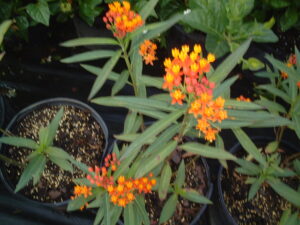S & J Nursery’s Guide to Growing
Scarlet Milkweed / Butterfly Weed / Tropical Milkweed
for the Northeast Florida Landscape
(Asclepias curassavica)
Scarlet / Tropical Milkweed is one of the easiest milkweed varieties to grow for our Northeast Florida landscapes and provides an abundance of food for the larva of the Monarch and Queen butterfly as well as blooms for butterflies and other pollinators from early spring until fall.
A WORD ABOUT PESTICIDES ON MILKWEEDS
Grown as a larval plant for the Monarch, Queen and Soldier Butterfly , our butterfly plants are grown here on site from seed, cuttings, or divisions and not treated with herbicides or pesticides. Making them available without added chemical toxins to the newly hatched caterpillars as a food source also puts them on the menu for other critters like Milkweed bugs and Aphids. In reality, you can’t have one without the other. Treating them in ANY way for the removal of the aphids etc. would also harm caterpillars as well as remove or kill the unhatched eggs laid on the plants by visiting butterflies. We like to leave them be and allow natures system of checks and balances to kick in to control pest populations. See Pesticides on Butterfly Plants for more information
Preferred Exposure for Scarlet Milkweed / Butterfy Weed / Asclepias curassavica:
– Butterfly weed will grow well in a full sun or partially shaded location in
our Jacksonville / St. Augustine area gardens.
Foliage, Size and Growth Habit of the Scarlet Milkweed / Butterfly Weed /
Asclepias curassavica:
Asclepias currasavica has alternate, narrow lance shaped medium to dark green leaves that can range from 3-8 inches in length and are
deciduous.
Size :
Butterfly weed can grow to heights
of 1-2 ft high and 1-2 ft wide and has a strongly upright growth habit.
Soil Preference / Salt tolerance of Asclepias curassavica:
– Scarlet milkweed is not that particular about the soil that it is planted
into and tends to thrive with little care in both dry soils and moist to wet soil areas.
– Salt tolerance for Asclepias curassavica is poor.
 Growth Rate:
Growth Rate:
– Moderate to fast growing plants, Asclepias curassavica can be expected to
reach its full height in the first or second growing season in the North Florida | Jacksonville | St. Augustine area landscape.
Bloom:
– Bright red / orange blooms in summer that are recognizable by
their typical milkweed petal pattern and count. Asclepias curassavica / Scarlet milkweed will have clusters of flowers that each have 10 petals, 5 down and outward facing red petals and 5 upward facing orange petals.
Water Requirements:
– Asclepias curassavica is a drought tolerant landscape selection but will
require supplemental watering when first planted into the landscape from an S & J Tree Farm and Nursery reusable container.
Butterfly, Pollinator or Bird Attracting:
– Butterfly Weed will attract both butterflies and birds to your gardens
landscape including Hummingbirds! It is a larval food source for Monarch, Queen and Soldier Butterflies.
Butterflies and other pollinators feed on the nectar the flowers provide.
Deer Resistance:
– Deer resistant perennial plant selection
Care of Asclepias curassavica in the Northeast Florida | Jacksonville | St.
Augustine area landscape:
– Water every other day during the establishment period, once plants have resumed growth in the landscape taper watering back to just a weekly application during prolonged droughts.
– Herbaceous perennial plant, but may be a bit slow to start in the spring, so
give them a bit of time to get growing again, they will be full of foliage to feed the butterflies by summer.
– Fertilize each spring with a shovel full of good garden compost.
***TRIM SCARLET MILKWEED DOWN TO JUST A FEW INCHES ABOVE THE
GROUND IN FALL EACH YEAR TO KEEP THE FOLIAGE FRESH AND HEALTHY FOR THE BUTTERFLIES ***
Click here for more information on
Scarlet Milkweed / Butterfly Weed / Asclepias curassavica
for the North Florida | Jacksonville | St. Augustine area landscape from UFIFAS.
http://floridata.com/Plants/Asclepiadaceae/Asclepias%20curassavica/652

